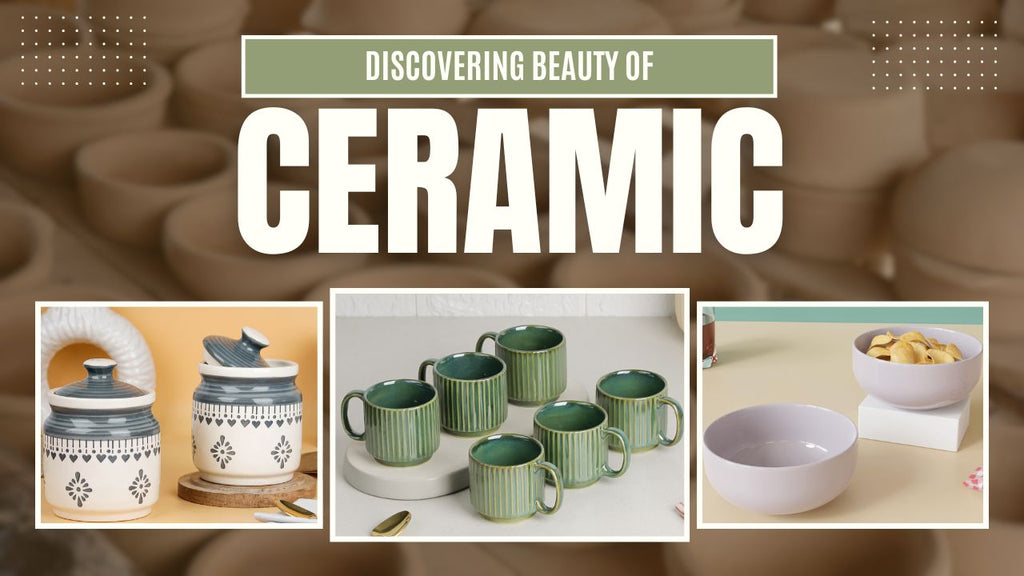The Popularity of Ceramic in Modern Living
Posted by MARKETING TES

Ceramic — a word that evokes images of delicately crafted mugs, minimalist dinnerware, artisanal home décor, and sustainable living. But ceramic is more than just an aesthetic choice; it's a timeless material that seamlessly blends form and function. In the world of lifestyle products, ceramic stands tall not only for its visual appeal but also for its practical benefits. From kitchen shelves to bathroom counters, and from decorative pieces to functional tableware, ceramics are everywhere — and for good reason.
What is Ceramic?
Ceramic refers to objects made from clay and hardened by heat. The term covers a wide range of materials including porcelain, stoneware, and earthenware. These are shaped and fired at high temperatures to create durable, non-metallic materials that are both versatile and aesthetically pleasing.
Why Ceramic is the Go-To Choice for Lifestyle Products
1. Aesthetic Appeal
Ceramics offer a unique blend of earthiness and elegance. The handmade feel, subtle imperfections, and natural textures add authenticity to any product.
-
Versatile Design: From rustic to modern, minimal to ornate — ceramics adapt to various design styles.
-
Color and Texture Variety: Glazed ceramics come in an array of colors and finishes, giving designers immense creative freedom.
2. Durability & Longevity
One of the biggest reasons ceramic remains a preferred choice is its resilience.
-
High-Temperature Resistance: Ceramics withstand extreme temperatures, making them perfect for cookware and bakeware.
-
Scratch and Chip Resistant: Good-quality stoneware and porcelain are highly resistant to wear and tear.
-
Low Maintenance: They don’t stain easily and are dishwasher safe (in most cases).
3. Sustainability
In a world leaning towards conscious consumption, ceramics have gained immense popularity for their eco-friendliness.
-
Natural Material: Made primarily from clay, ceramic is abundant and non-toxic.
-
Recyclable and Biodegradable: Unlike plastic or synthetic materials, ceramic products are biodegradable and can be recycled.
-
Low Environmental Impact: Ceramic production (especially artisanal) often has a smaller carbon footprint compared to industrial materials like plastic or metal.
4. Health and Safety
Ceramic is one of the safest materials for food and drink-related products.
-
Non-Toxic: Unlike plastic, ceramics do not leach harmful chemicals into food or drink.
-
Odor and Stain Resistant: They don’t retain odors or food stains, making them hygienic for daily use.
-
Lead-Free Options: Modern ceramics are available in lead-free, food-safe varieties, especially important for dinnerware and cookware.
5. Thermal Insulation
Ceramics retain heat effectively, which is why your tea stays warm longer in a ceramic cup.
-
Ideal for Cookware: Heat distribution is even, reducing the risk of hotspots or uneven cooking.
-
Comfort in Use: Ceramic mugs and bowls are warm to the touch, adding comfort to everyday rituals.
6. Artisanal Value
Each ceramic piece tells a story — of tradition, craftsmanship, and cultural richness.
-
Handcrafted Appeal: Many ceramic items are handmade or hand-glazed, giving them unique character.
-
Support Local Artisans: Buying ceramic supports craft communities and promotes local economies.
Popular Lifestyle Categories Featuring Ceramic
Here are some common lifestyle categories where ceramic is a dominant material:
● Kitchen & Tableware
● Home Decor
● Bathroom Accessories
-
Soap dishes, toothbrush holders, lotion dispensers.
● Garden & Outdoor
-
Ceramic pots, bird feeders, and garden stools.
Ceramic vs. Other Materials
| Feature | Ceramic | Plastic | Metal | Glass |
|---|---|---|---|---|
| Aesthetic | Natural, Handmade Feel | Mass-produced look | Industrial | Fragile, Sleek |
| Durability | High (in quality types) | Low | High | Fragile |
| Eco-friendliness | High | Low | Medium | Medium |
| Health Safety | High | Low | Medium | High |
| Heat Resistance | Excellent | Poor | Excellent | Good |
Final Thoughts
Ceramics are not just a design trend; they are a lifestyle philosophy. They represent a conscious shift toward sustainability, authenticity, and artistry in everyday living. Whether you're sipping chai from a hand-thrown mug or plating dinner on a rustic ceramic plate, you're choosing more than functionality — you're embracing a story, a tradition, and a timeless material that continues to adapt and inspire.
In a fast-paced world of fleeting trends and disposable goods, ceramic stands as a symbol of lasting value and mindful living.
Thinking of elevating your home or kitchen aesthetic? Choose ceramic — where beauty meets purpose.


